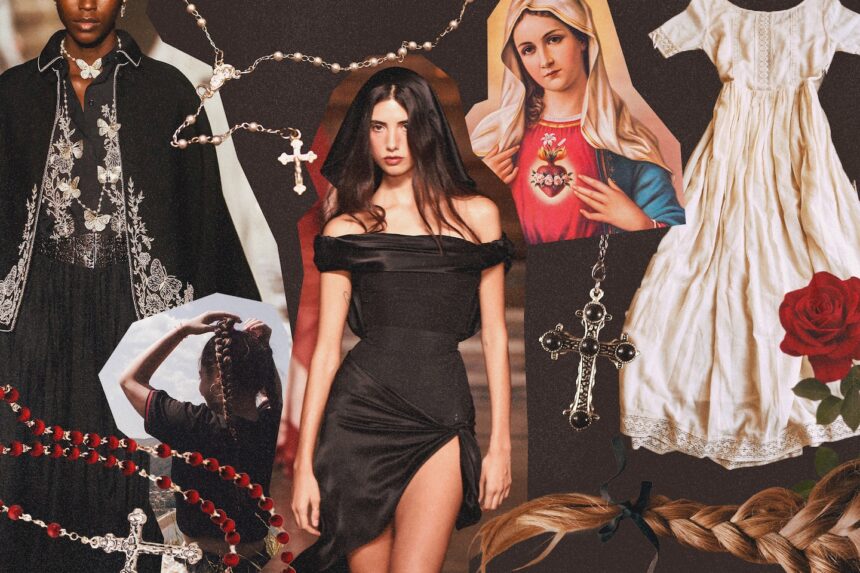She was the muse for a 2022 collection, Collection III, from Mirror Palais, the New York label that has achieved cult status for its romantic, sensual designs. Its campaign photography featured Garza posing in front of the Spanish architecture of San Miguel de Allende, a colonial-era Mexican city, in lacy white petticoats and sheer black dresses. Brand founder and designer Marcelo Gaia, who was raised in Queens by his Brazilian immigrant mother, has said he decided on the “Spanish-built” cobblestone city on the recommendation of his assistant art director.
Over the past year, Garza and Mirror Palais have come to represent a growing fashion trend where purportedly “Old World” colonial aesthetics are romanticized and updated for the internet age under the label “Catholic Mexican Girl”-core. Think: white dresses, braids, red accents, gold jewelry and crucifixes. There’s a virginal quality to the look, yet it’s not quite modest: Bare shoulders and exposed midriffs underscore the potential for sexuality.
On TikTok, where the look first caught steam late last year, videos for “Catholic core Mexican outfits” have 6.5 billion views and counting. One video that says “thank you Latinas for this aesthetic” features murals of the Mexican Virgen de Guadalupe, giant golden cross necklaces and Salma Hayek in a white, low-waisted skirt set. With its cap sleeves and plunging sweetheart neckline, Mirror Palais’ out-of-stock Maria dress ($625), its name a potential reference to the Virgin Mary, was so popular that it led to countless fast-fashion knockoffs.
But the popularity of Catholic Mexican Girl style has also raised questions about the ways in which U.S. consumers understand and represent Latin American communities, and the violent history of Spanish colonialism. The label — which comes not from the designers but rather those who buy and reproduce the aesthetic — reflects an impulse to whittle down the staggering diversity of what is considered “Latin America” into ready-made categories easily recognizable by Americans: the (light-skinned) “Mexican,” the Catholic, the girlishly feminine.
“I don’t see my culture as a trend,” said Andrea Bejar, a 22–year-old Miami-based singer-songwriter from Mexico. “I just think that it’s so much more than that.” Although she said it’s “really cool” to see gorgeous fashion inspired by her home country, “it’s important to know where the inspiration comes from and the cultural background behind everything.” To be Catholic in Mexico, for example, can be a very sacred thing.
When Bejar thinks of her hometown in Cuernavaca, she pictures “vibrant colors, visiting family, las haciendas: the very typical things that are portrayed in these types of [social media] images.” It’s this combination of Latin American traditions and Spanish colonial influences (the haciendas) that lend themselves to Catholic Mexican Girl style.
“What do we share across Latino ethnic groups?” asks Brian Eugenio Herrera, an associate professor of theater at Princeton University. “It’s different encounters with the apparatus of Spanish coloniality, which is Catholicism, which is architecture, which is language.”
Similar to how aesthetics such as “tradwife” (think old-school roles for women) and dark academia (New England prep with a touch of Gothic terror) are being taken up and celebrated on social media, Catholic Mexican Girl plays into a broader trend among certain internet circles to fetishize traditionalist tropes. More specifically, it draws inspiration from films such as “Like Water for Chocolate,” which is having a moment on TikTok, and 2021’s “Encanto.” Although these films don’t take place during Spanish colonialism, they call to it visually by idealizing “the attire, the locales, the sense of mystery, the sense of possibility and also the sense of confinement or conscription for women” of colonial Latin America, Herrera said. Indeed, “Encanto’s” Spanish-style Casa Madrigal, nestled deep in the mountains of Colombia, could very well be the setting of a Mirror Palais shoot.
Even “West Side Story,” which saw its celebrated return to the silver screen in 2021, falls into similar patterns. In her white dress and red belt, Rachel Zegler’s pious Maria would not be out of place on a Catholic Mexican Girl mood board.
When Mirror Palais’ Gaia was accused by a TikTok user of “adding to the ‘catholic mexican girl aesthetic’” with his Collection III designs, he responded in a TikTok that it “was not inspired, by any means, by Mexico specifically” but by his culture and Brazil, which is also a devout Catholic country. “The collection itself had nothing to do with Mexico.”
And yet the term has proved lasting, fueled by an array of global brands interpreting the look. This summer, the British fast-fashion brand Motel launched its La Rossa collection, a clear nod to these stereotypically Latin American Catholic aesthetics. And for Dior’s 2024 Cruise collection in May, which was staged in Mexico City’s Colegio de San Ildefonso, Italian creative director Maria Grazia Chiuri sent models down the runway in white and black dresses embroidered with red thread, Indigenous huipil silhouettes and Spanish-style bolero tailoring.
Chiuri has said that the collection, which was produced in collaboration with artists from the Mexican states of Oaxaca, Chiapas and Puebla, was inspired by Kahlo. The vast majority of models wore their hair in two braids, a hairstyle strongly associated with Indigenous communities in Latin America. There were also nunlike collars, presented against the arches of the Colegio de San Ildefonso, a colonial 16th-century institution founded by Jesuit evangelists.
The reworking of Catholic or otherwise religious symbolism into fashion isn’t new. Back in 2018, the “Heavenly Bodies”-themed Met Gala riffed on papal pageantry. In 2021, brands such as Praying popularized the subversion of traditionally Catholic tropes (e.g., “Father, Son, Holy Spirit” bikinis). The current Catholic-core is more explicit in its appropriation of devotional signifiers, complete with palm rosaries and vintage altarpieces.
The white dresses can be traced directly to the attire worn in 18th-century Spanish colonies, according to Marta Valentín Vicente, a professor at the University of Kansas who focuses her research in part on sexuality and women’s history in 18th-century Spain. The style, she said, recalls the white cotton muslin clothing expected of Spanish women in the Americas at the time, as reflected in 18th-century casta paintings codifying racial appearances in New Spain. These cotton fabrics were “very expensive and associated with the more powerful classes and European fashion,” Vicente said, noting that they “connect with questions of race, of whiteness and privilege.”
Critics say that, by viewing Latin American culture strictly through the lens of Spanish colonialism, Black and Indigenous people are essentially erased from view. “In some ways, the simplicity of the white dress also ends up reasserting the whiteness of Latinos,” Herrera said.
The first Spanish invaders, so-called conquistadors like Cortés and Pizarro, and even Columbus, were devotees to the Virgin. In fact, they would kneel to pray in front of the Spanish Virgen de Guadalupe in Cáceres, Spain, before leaving for the “New World.” The majority of the religious fraternities in the colonial Americas were also dedicated to the Virgin Mary, said Ximena A. Gómez, an assistant professor of American art at the University of Massachusetts at Amherst, where she specializes in the art and visual culture of colonial Latin America. “You can’t have the colonial project without the Virgin Mary,” she said.
Gómez collects images of the Virgin Mary and describes herself as “culturally Catholic.” Speaking of the Catholic Mexican Girl trend and its fixation on Marian imagery, she said she was “really excited to see something like this get taken up outside of my niche communities. On the other hand, the secularization of an aesthetic that is very much complicated, historically, religiously and culturally, struck me as very problematic.”
At issue, she said, is its “uncritical” approach. Whereas Latin American scholars, artists and activists are actively engaging with the image of the Virgin Mary, here it’s not being “met with a larger awareness of things that Latin American [and] Latinx people … have been accustomed to” when it comes to the legacies of Spanish colonialism. These include ongoing issues of anti-Blackness, anti-Indigeneity and machismo in Latin American cultures.
By presenting an alternative femininity, one that is pure and girlish, Catholic Mexican Girl-core resists hypersexual depictions of Latin American femininity — the stereotypical “fiery” Latina label bestowed upon, say, Cardi B or Kali Uchis — without necessarily expanding beyond it. Instead, it reinforces another category for Latina women to fit into that feeds into the Madonna-whore complex. With its focus on accentuated curves, exposed shoulders and ankle-skimming skirts, the trend, Herrera said, “is obsessed with the potency of women’s sexuality,” despite it not “expressing or displaying it.” White and black dresses propose a binary idea of femininity — pure vs. mature and tempered — while the deep red of ribboned braids or cherry lips foregrounds an inherent sexuality.
Herrera, who focuses his work on issues of race, gender and sexuality, has written extensively about how U.S. pop culture goes through waves of wanting to “perform” Latina aesthetics every few years. He calls these periods of time “Latin Numbers,” during which Latino communities are both redefined and “discovered.”
It’s possible that we’re living in one of these moments now. In 2022, Bad Bunny became the most-streamed artist on Spotify for the third year in a row, garnering more than 18.5 billion streams in 12 months. “Chola” aesthetics from Black and Latina women have been rebranded as “clean girl” and have taken the internet by storm. Spanish singer Rosalía “feel[s] Latina.” Jenna Ortega is the latest it girl. And Latino and Latin American communities have also been at the center of some of the past few years’ buzziest movies: “Encanto,” “West Side Story,” “In the Heights” and others.
These moments also come with a renewed desire to look like or “perform” Latin American aesthetics. It’s this thinking that undergirds the Catholic Mexican Girl trend, which packages and sells the desire to look Latina to a U.S. market. It’s also what makes the trend so complicated. Although it’s beautiful for someone to reference their culture in an artful way, “that gets completely calcified when it’s put on a popular level,” Gómez said.
Part of what connects these periods of rediscovery is their ahistoric quality. When they’re visible, Latino communities in the United States are often marketed as new or up-and-coming, rhetoric that ends up “erasing and effacing prior histories,” Herrera said. When Ortega and Pedro Pascal were announced as Emmy nominees last month, for example, they were heralded as the “first” Latino actors to be nominated in leading categories, “since 2008.”
“And the crucial part,” Herrera said, “about when Latinos or Latine populations or Latinx folks get in this space of being discovered, … I always hear in my head and in my heart the clock ticking of, ‘When are they going to be forgotten and erased?’”











